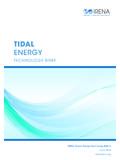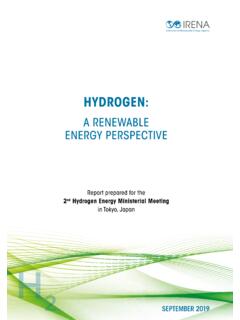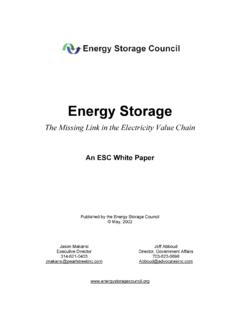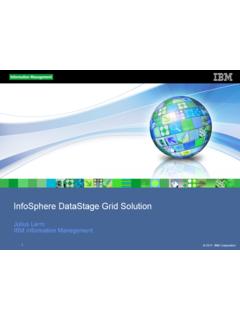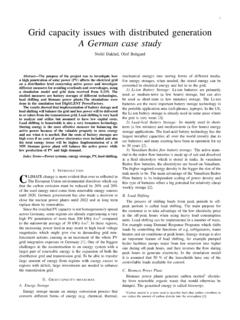Transcription of BATTERY STORAGE FOR RENEWABLES: MARKET …
1 BATTERY STORAGE . FOR RENEWABLES: MARKET STATUS. AND TECHNOLOGY. OUTLOOK. JANUARY 2015. Copyright IRENA 2015. Unless otherwise stated, this publication and material featured herein is the property of the International renewable Energy Agency (IRENA) and is subject to copyright by IRENA. Material in this publication may be freely used, shared, copied, reproduced, printed and/or stored, provided that all such material is clearly attributed to IRENA, and bears a notation that it is subject to copyright by IRENA, with the year of the copyright ( , IRENA, year of publication). Material contained in this publication attributed to third parties may be subject to third party copyright and separate terms of use and restrictions, including restrictions in relation to any commercial use. About IRENA. The International renewable Energy Agency (IRENA) is an intergovernmental organisation that supports countries in their transition to a sustainable energy future, and serves as the principal platform for international cooperation, a centre of excellence, and a repository of policy, technology, resource and financial knowledge on renewable energy.
2 IRENA promotes the widespread adoption and sustainable use of all forms of renewable energy, including bioenergy, geothermal, hydropower, ocean, solar and wind energy, in the pursuit of sustainable development, energy access, energy security and low-carbon economic growth and prosperity. Acknowledgements Special thanks go to the participants of IRENA International Energy STORAGE Policy and Regulation workshops on 27 March 2014 in Dusseldorf, Germany, on 7 November 2014 in Tokyo, Japan, and on 3. December 2014 in New Delhi, India. The final report has benefited from valuable comments provided by external reviewers Greg Albright and Jake Edie (AllCell Technologies, USA), Penelope Crossley and Anthony Vassallo (University of Sydney), Anissa Dehamna (Navigant Research), Paul Denholm (National renewable Energy Laboratory), Ben Kaun (Electric Power Research Institute), Michael Koller (Elektrizit tswerke des Kantons Z rich), Thomas Leyden (Solar Grid STORAGE ), Matthew Maroon (Aquion Energy), Maik Naumann (Technical University Munich, Germany), Dudley Achu Sama (Valdas & Co.)
3 Ltd), Inka Schrader (Ecoult), and Sandra Retzer (Younicos, Germany). Authors: Ruud Kempener (IRENA) and Eric Borden For further information or to provide feedback, please contact: IRENA, Innovation and Technology Centre (IITC). E-mail: or Disclaimer This publication and the material featured herein is provided as is , for informational purposes only. All reasonable precautions have been taken by IRENA to verify the reliability of the material featured in this publication. Forward looking projections are inherently uncertain. A complete understanding of the assumptions underlying the conclusions and the methodologies used to create such projections may be sought from the party to whom such projections are attributed. Neither IRENA nor any of its officials, agents, data or other third-party content providers or licensors provide any warranty, including as to the accuracy, completeness, or fitness for a particular purpose or use of such material, or regarding the non-infringement of third party rights, and they accept no responsibility or liability with regard to the use of this publication and the material featured therein.
4 The information contained herein does not necessarily represent the views of the Members of IRENA, nor is it an endorsement of any project, product or service provider. The designations employed and the presentation of material herein do not imply the expression of any opinion on the part of IRENA. concerning the legal status of any region, country, territory, city or area or of its authorities, or concerning the delimitation of frontiers or boundaries. CONTENTS. LIST OF FIGURES IV. LIST OF TABLES V. LIST OF BOXES V. LIST OF ACRONYMS VI. 1 EXECUTIVE SUMMARY 1. 2 INTRODUCTION AND BACKGROUND 3. 3 OVERVIEW OF BATTERY STORAGE 6. Factors affecting BATTERY selection 8. 4 APPLICATIONS OF BATTERY STORAGE FOR renewable INTEGRATION 11. BATTERY STORAGE islands and off-grid applications 12. Household solar PV 14. Variable renewable energy smoothing and supply shift 17. Fast regulation in grids with high variable renewable energy shares 18.
5 5 BATTERY STORAGE IN THE POWER SECTOR, MARKET ANALYSIS 23. MARKET overview 23. Analysis of BATTERY types 26. Country analysis 31. 6 SUMMARY AND CONCLUSION 39. ANNEX A 41. Overview of technical characteristics for particular BATTERY types 41. REFERENCES 46. BAT T E RY STO R AGE F O R RE N E WA BLE S : M A RK E T S TATUS A N D TE C H N O LO G Y O UTLOOK i List of Figures Figure 1: Flexibility resources in the electricity 4. Figure 2: Illustration of depth of discharge versus cycle life - Hoppecke Opzv lead-acid sun-power Figure 3: BATTERY STORAGE system and primary power Figure 4: Important considerations for BATTERY 9. Figure 5: Important considerations for BATTERY selection by 9. Figure 6: Services provided by energy 11. Figure 7: Island renewable energy production, impact of BATTERY 12. Figure 8: Net Present Value of energy STORAGE technologies integrated in remote microgrid world markets, 13.
6 Figure 9: Solar PV and BATTERY 15. Figure 10: Illustration of BATTERY STORAGE power Figure 11: Illustration of energy supply Figure 12: Illustration of fast response wind output and deployed regulation in Figure 13: 100 MW BATTERY STORAGE (left) versus 100 MW gas turbine (right).. 21. Figure 14: 2014 regional BATTERY STORAGE cell sales for utility-scale applications (USD thousands).. 23. Figure 15: Worldwide forecast of BATTERY STORAGE capacity (MW) and annual revenue (USD). for utility-scale Figure 16: BATTERY MARKET supply 25. Figure 17: Advanced BATTERY STORAGE technologies for utility-scale applications, installed capacity (MW) by top ten companies in 25. Figure 18: Estimated installed BATTERY capacity and commissions (MW) in the power sector by type, Figure 19: Recent lithium-ion BATTERY cost Figure 20: Lowest current and projected BATTERY cell price by type for utility-scale Figure 21: Lowest cell price of lithium-ion chemistries for utility-scale Figure 22: Estimate of operational and planned BATTERY STORAGE (MW).
7 In the power sector by 32. Annex A, Figure 1: Advanced lead-acid BATTERY design Annex A, Figure 2: Sample BATTERY data sheet, ii BATTERY STO RAG E F O R R E NEWA B L E S: M A R K E T S TATUS A N D TE C H N O LO G Y O UTLO O K. List of Tables Table 1: Calculating cost of BATTERY STORAGE systems available in the German MARKET 28. Table 2: Procurement of energy STORAGE by Southern California Edison in 2014 33. Table 3: Overview of BATTERY STORAGE projects in South Korea 38. Annex A, Table 1: Lithium-ion subcategory characteristics 43. List of Boxes Box 1: Case study: Alaska, , island frequency Box 2: Case study: New Mexico, US, solar PV smoothing and energy Box 3: Case study: Doha, Qatar, frequency response and other ancillary Box 4: Sustainability of batteries and access to raw 22. Box 5: Case study: Rokkasho, Aomori, Japan, wind energy time shift and frequency 27. Box 6: BATTERY system costs and Levelised Cost of Energy (LCOE).
8 28. Box 7: Case study: Angola, Africa, off-grid school 31. Box 8: Case study: Germany, support for household solar and BATTERY Box 9: Case study: Zhangbei, China, wind energy time shift and ancillary 37. BAT T E RY STO R AGE F O R RE N E WA BLE S : M A RK E T S TATUS A N D TE C H N O LO G Y O UTLOOK iii LIST OF ACRONYMS. AC Alternating current Hz Hertz ARRA American Recovery and Reinvestment Act IEA International Energy Agency BNEF Bloomberg New Energy Finance IRENA International renewable Energy Agency CPUC California Public Utilities Commission KfW Kreditanstalt f r Wiederaufbau DoD Depth of discharge KEA Kodiak Electric Association DC Direct current kW Kilowatt kWh Kilowatt hours DOE Department of Energy kWp Kilowatt peak EIA Energy Information Administration MW Megawatt EPRI Electric Power Research Institute MWh Megawatt hour EV Electric vehicle MT Metric tonnes ERCOT Electric Reliability Council of Texas NREL National renewable Energy Laboratory FERC Federal Energy Regulatory Commission PV Photovoltaic FiT Feed-in tariff REN21 renewable Energy Policy Network for the 21st GW Gigawatt Century GWh Gigawatt hour United States of America GWEC Global Wind Energy Council Wh Watt
9 Hour iv BATTERY STO RAG E F O R R E NEWA B L E S: M A R K E T S TATUS A N D TE C H N O LO G Y O UTLO O K. 1 EXECUTIVE SUMMARY. For over a century, energy STORAGE in the power sector electricity supply reliability. These application areas are has been dominated by one technology pumped listed below. hydropower STORAGE . Along with the rest of the sector, that is beginning to change. renewable energy deploy- island systems and off-grid/rural electrification ment and policies to modernise electricity production with renewable energy deployment and consumption are propelling numerous advances, households with solar photovoltaic (PV). including increased BATTERY STORAGE . This technology variable renewable energy smoothing and energy stores energy chemically and can be located at the supply shift (see figure 10 and 11 for examples). point of demand or at the grid level. Its use can allow for fast, short-term electricity balancing in ancillary greater amounts of renewable electricity and contribute markets to system reliability.
10 Key drivers to BATTERY deployment vary by application From a technological perspective, BATTERY STORAGE is and requirements are unique to each location. For mature and there are hundreds of suppliers providing islands and off-grid applications, they include the reliable systems. However, several barriers have to be high cost of diesel fuel and a desire to integrate overcome before BATTERY STORAGE is fully integrated as greater amounts of variable renewable energy while a mainstream option in the power sector. These include maintaining electricity supply reliability. Solar PV and performance and safety issues, regulatory barriers, and BATTERY STORAGE at the household level is driven by utility acceptance. Nevertheless, recent developments government support, concerns over electricity supply have demonstrated that these barriers can be and in areas with a weak grid and economic trends.





